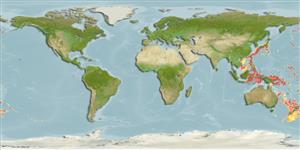Common names from other countries
Classification / Names / Names
Common names | Synonyms | Catalog of Fishes (gen., sp.) | ITIS | CoL | WoRMS
Environment: milieu / climate zone / depth range / distribution range
Ecology
Benthic; depth range 300 - 1500 m (Ref. 343). Tropical
Western Pacific: Japan to Palau.
Length at first maturity / Size / Weight / Age
Maturity: Lm ? range ? - ? cm Max length : 30.0 cm CW male/unsexed; (Ref. 343)
Carapace hexagonal; dorsal surface (especially branchial regions) distinctly inflated; anterolateral teeth low in adults. Merus of legs long, slender, with dorsal subdistal tooth; dactylus of legs laterally flattened, height at midlength less than width at midlength. Color: uniform tan to cream color overall.
Commands high prices of up to US$60 to US$80 for a fresh crab of 20 cm width.
Life cycle and mating behavior
Maturity | Reproduction | Spawning | Eggs | Fecundity | Larvae
Members of the order Decapoda are mostly gonochoric. Mating behavior: Precopulatory courtship ritual is common (through olfactory and tactile cues); usually indirect sperm transfer.
Ng, P.K.L. 1998. (Ref. 343)
IUCN Red List Status (Ref. 130435: Version 2024-1)
CITES status (Ref. 108899)
Not Evaluated
Not Evaluated
Human uses
Fisheries: commercial
FAO - Fisheries: landings | FishSource | Sea Around Us
Tools
Internet sources
Estimates based on models
Preferred temperature
(Ref.
115969): 2.7 - 4.1, mean 3.4 (based on 414 cells).
Vulnerability
Low vulnerability (20 of 100).
Price category
Unknown.
